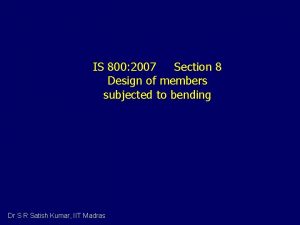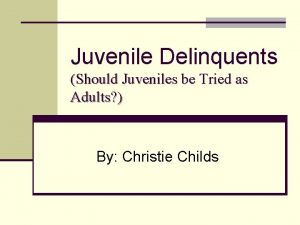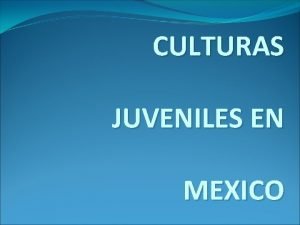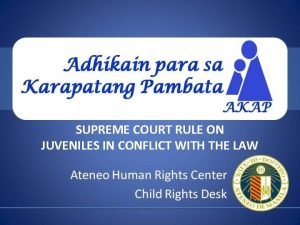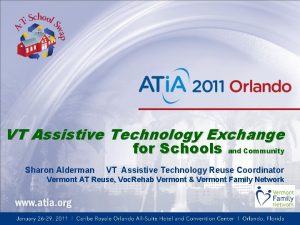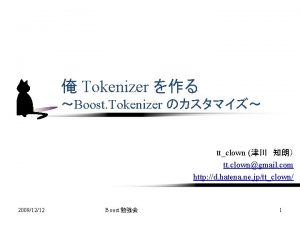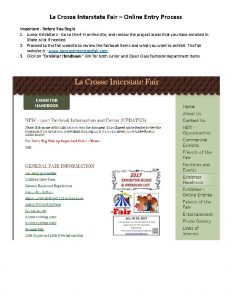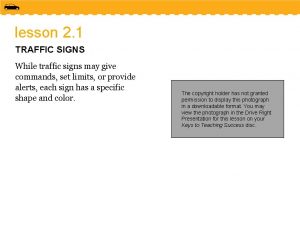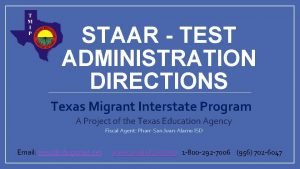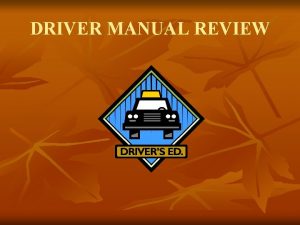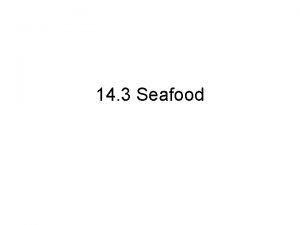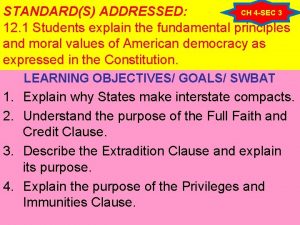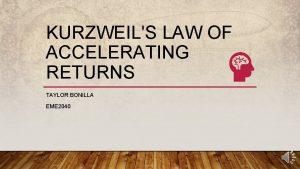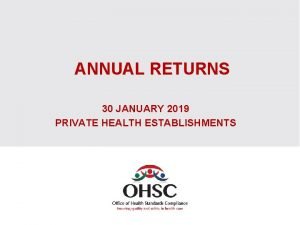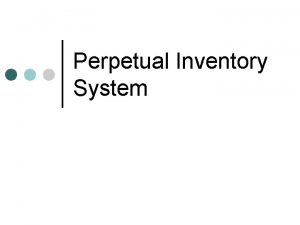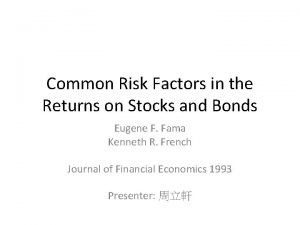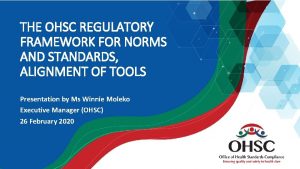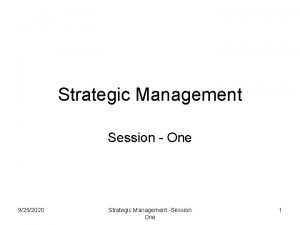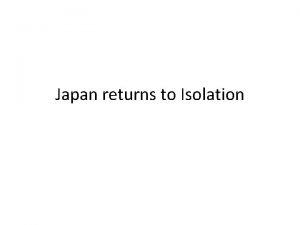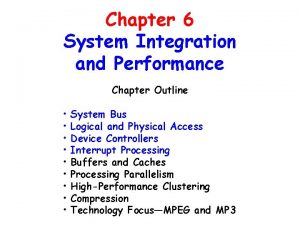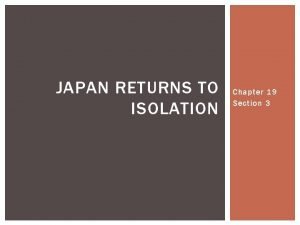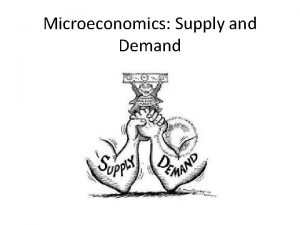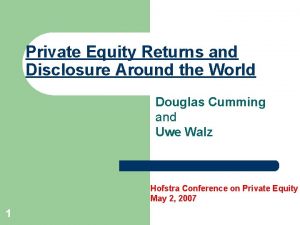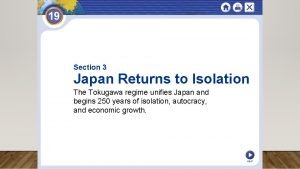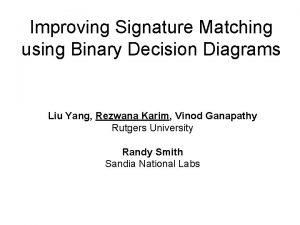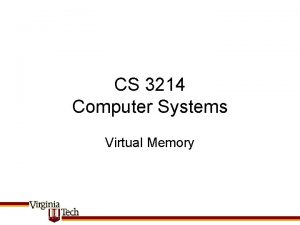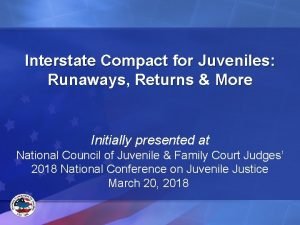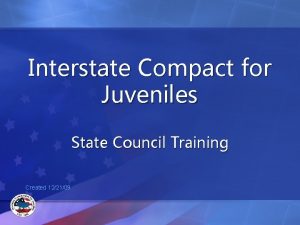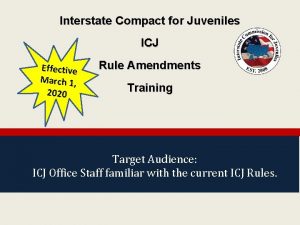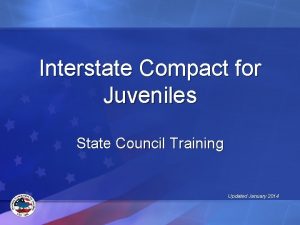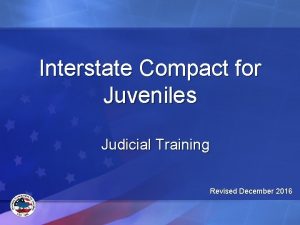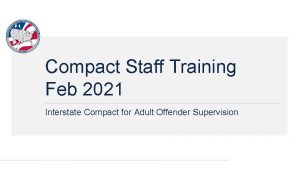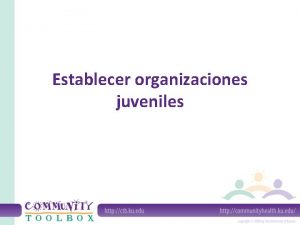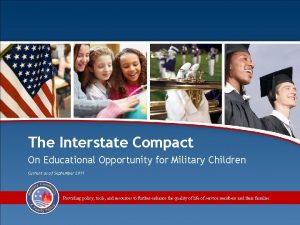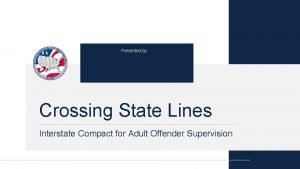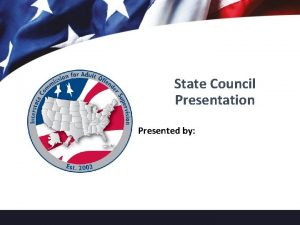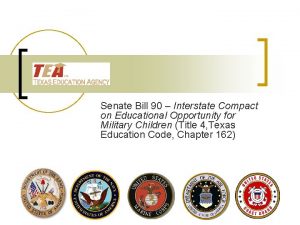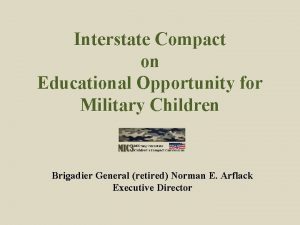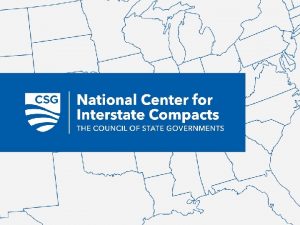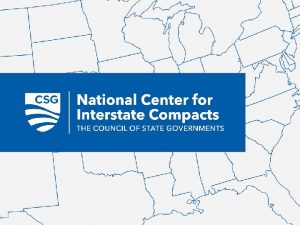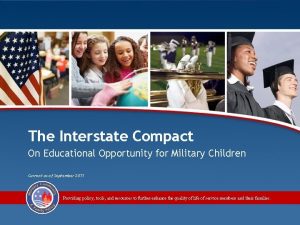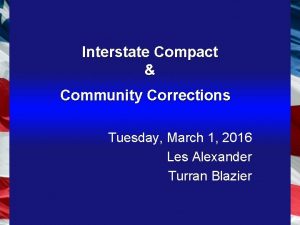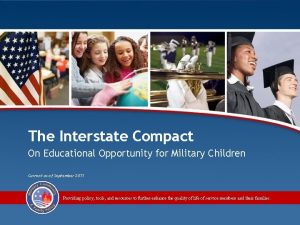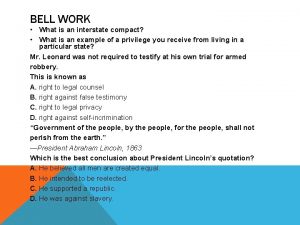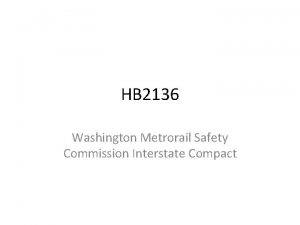Interstate Compact for Juveniles 101 Runaways Returns More



























































- Slides: 59

Interstate Compact for Juveniles 101: Runaways, Returns & More Interstate Commission for Juveniles REV. March 1, 2020

Learning Objectives • Identify 3 ways a juvenile can be returned • Distinguish between voluntary & non-voluntary returns • Identify differences in procedure for nondelinquent runaways vs. escapees, absconders and accused delinquents • Understand correlation between ICJ, runaways, human trafficking Serving Juveniles While Protecting Communities 2

Interstate Compact for Juveniles Authorized by: § U. S. Constitution, Compact Clause, Art. 1 § 10 § Crime Control Act, 4 U. S. C. § 112 (1965) • Adopted by all 50 states, DC, USVI • Binding regulatory compact that: 1. governs movement of delinquent and status offense juveniles, and 2. creates a commission with broad rulemaking & enforcement powers. Serving Juveniles While Protecting Communities 3

ICJ Rules: Binding & Supersede State Laws • ICJ explicitly delegates rulemaking authority to Commission - ICJ Art. VI • ICJ Rules are binding on compacting states - ICJ Art. XIII (B) • When state laws conflict, ICJ supersedes – ICJ Art. XIII (A) • For discussion, see ICJ Bench Book, Chapter 1 Serving Juveniles While Protecting Communities

Compliance & Enforcement 1. State-Level Enforcement • Courts & executive agencies must enforce by taking all necessary actions to effectuate ICJ’s purposes 2. Commission-Level Enforcement: • • • Remedial training & technical assistance Alternative dispute resolution Fines Suspension or termination from Compact Litigation

Distinctions between ICJ & ICPC ICJ ICPC Delinquency & Runaways Abuse and/or Neglect Revised ICJ adopted by 50 states, DC, USVI Not all states have adopted revised ICPC JIDS electronic data system NIECE Data System Includes explicit remedies for enforcement Does not include explicit remedies (still enforcable under Constitution & contract law) Serving Juveniles While Protecting Communities 6

ICJ Applies when a Juvenile: § Has run away from home & left their state of residence; § Is on probation, parole, or other supervision, or has escaped to another state; or § Has been accused of an offense in another state Serving Juveniles While Protecting Communities 7

Uniform Extradition Act Not Applicable • ICJ permits juveniles to reside & be supervised in state where they have family & community ties. In exchange, Juvenile is bound by ICJ, including Rules 4 -102(2) & 5 -103(3) (re: Waiver of Extradition) • Juvenile is subject to ICJ’s “alternative procedures”, not Uniform Criminal Extradition & Rendition Act (UCERA) • See ICJ Bench Book, 4. 2. 2 Serving Juveniles While Protecting Communities

ICJ FY 2019 Statistics Nationwide • Transfers of Supervision: 5, 026 • Returns: 1, 980 • Travel Permits: 6, 984 Serving Juveniles While Protecting Communities 9

Who Runs Away? Non-delinquent juveniles Juveniles who flee to another state (i. e. escapee, absconder, accused delinquent) Serving Juveniles While Protecting Communities 10

Voluntary vs. Non-Voluntary Returns Voluntary • Juvenile in custody agrees to return to home/demanding state • “Consent for Voluntary Return” (ICJ Form III) Non. Voluntary • Juvenile refuses to return to home/demanding state; may not be in custody • “Requisition” (ICJ Form I or Form II) Serving Juveniles While Protecting Communities 11

Returning Runaways

Non-delinquent Runaways First 24 Hours (ICJ Rule 6 -101) • Authorities may release runaway to parent/legal guardian within 24 hours of detainment, EXCEPT when abuse/neglect is suspected. • After 24 hours, holding authorities contact the holding state’s ICJ office. Serving Juveniles While Protecting Communities 13

Runaways: Abuse/Neglect (ICJ Rule 6 -105) • Holding state notifies home state’s ICJ Office • Home state’s ICJ Office works with home state’s authorities and/or court to safely return juvenile • If voluntary return, Form III (Consent for Voluntary Return) must indicate who will assume responsibility for juvenile • If unwilling to voluntarily return, Requisition is initiated by home/demanding state’s authorities. See ICJ Rule 6 -103(10) • Juvenile must still be returned within time frames Serving Juveniles While Protecting Communities 14

Secure Detention ICJ Rules 6 -102(1) & 6 -103(1) • Runaways shall be held in secure facilities if they are danger to themselves or others. • Holding state has discretion to hold those who are not danger to themselves or others at location it deems appropriate. OJJDP Exclusion Juveniles held pursuant to ICJ are excluded from JJDPA’s deinstitutionalization of status offenders (DSO) requirements. See ICJ Bench Book, Appendix VI, Memo re: OJJDP Policy on Secure Detention Serving Juveniles While Protecting Communities 15

Voluntary Returns Non-Delinquent Runaways, Escapees, Absconders, and Accused Delinquents Serving Juveniles While Protecting Communities

Voluntary Return Process – ICJ Rule 6 -102(10) • Juvenile shall be returned within 5 business days of receiving signed Form III (Consent for Voluntary Return) or Adult Waiver. • May be extended additional 5 business days with approval from both ICJ offices. Serving Juveniles While Protecting Communities 17

Process Chart in ICJ Bench Book Serving Juveniles While Protecting Communities 18

Non-Voluntary Returns Non-delinquent runaways and/or accused status offenders Rule 6 -103 Escapees, absconders, or accused delinquents Rule 6 -103 A Serving Juveniles While Protecting Communities 19

Non-Voluntary Return of Runaways & Accused Status Offenders ICJ Rule 6 -103 Serving Juveniles While Protecting Communities

Process Chart in ICJ Bench Book • Consider adding picture of Process Chart Serving Juveniles While Protecting Communities 21

Requisition of Runaway/Accused Status Offender • Requisition applies to all juveniles in custody who – refuse to voluntarily return or – to request a juvenile whose whereabouts are known, but not in custody, be picked up & detained pending return. • Legal guardian or custodial agency SHALL petition court in home/demanding state for Requisition. – If juvenile is already in custody, must be within 60 days of notification of juvenile’s refusal to voluntarily return. Serving Juveniles While Protecting Communities 22

Requisition by State Authorities: ICJ Rule 6 -103(10) • Home/demanding state’s appropriate authority begins Requisition process when: • Notified by holding state’s ICJ office of juvenile’s refusal to return voluntarily, AND • Legal guardian or custodial agency is unable or refuses to initiate Requisition, • 60 day maximum timeframe applies • Appropriate process when abuse/neglect allegations made and home state determines juvenile will not return to the legal guardian. Serving Juveniles While Protecting Communities 23

Hearing on Requisition - ICJ Rule 6 -103(5 -6) • Hearing within 30 days of receipt of Requisition. • “Purpose of said hearing is to determine proof of entitlement for the return of the juvenile. ” – If Requisition packet in order, holding state’s court shall order juvenile be returned ** “Best interest” standard determined by home/demanding state’s court. Serving Juveniles While Protecting Communities

Hearing & Findings Approve if Proof of Entitlement Established • Court orders juvenile’s return • Juvenile shall be returned within 5 business days Deny if Proof of Entitlement NOT Established • Court shall issue written findings detailing the reason(s) for denial Serving Juveniles While Protecting Communities

Non-Voluntary Return of Escapees, Absconders or Accused Delinquents ICJ Rule 6 -103 A “A requisition applies to all juveniles in custody who refuse to voluntarily return to their home/demanding state or to request a juvenile whose whereabouts are known, but not in custody be picked up and detained pending return. “ Serving Juveniles While Protecting Communities

Detention & Requisition of Escapees, Absconders or Accused Delinquents • If in custody on a warrant, these juveniles shall be detained in secure facilities until returned. • Demanding state’s ICJ Office presents Requisition to demanding state’s court to request juvenile’s return, along with documents to prove entitlement. • When juvenile is in custody, this shall be within 60 days of notification of refusal to voluntarily return. • Demanding state’s court shall determine whether proof of entitlement has been established, and, if so, sign Requisition Serving Juveniles While Protecting Communities

Holding State’s Hearing on Requisition • Hearing within 30 days of receipt of Requisition. • If juvenile is detained when Requisition received, court shall order juvenile be held pending a hearing on the Requisition. • “Purpose of said hearing is to determine proof of entitlement for the return of the juvenile. ” – If Requisition packet in order, court shall order juvenile be returned ** “Best interest” standard determined by home/demanding state’s court. Serving Juveniles While Protecting Communities

Hearing & Findings Approve if Proof of Entitlement Established • Court orders juvenile’s return • Juvenile shall be returned within 5 business days Deny if Proof of Entitlement NOT Established • Court shall issue written findings detailing the reason(s) for denial Serving Juveniles While Protecting Communities

Retaking (Return by Sending State After Failed Supervision) Serving Juveniles While Protecting Communities

Retaking – ICJ Rule 1 -101 & 5 -103 “The act of a sending state physically removing a juvenile, or causing to have a juvenile removed, from a receiving state. ” 31 Serving Juveniles While Protecting Communities

Sending State’s Authority to Retake After Violation ICJ Rule 5 -103(3) • Sending state has conclusive authority to retake juvenile on probation or parole – If juvenile is suspected of committing criminal offense or act of delinquency in receiving state, sending state may NOT retake juvenile without prior consent from receiving state’s authorities. – No further court procedures are required • Form IA/VI (Application for Services & Waiver). • Officer of sending state may enter receiving state and retake a juvenile on probation/parole – If this is not practical, warrant may be issued & supervising state shall honor warrant in full. Serving Juveniles While Protecting Communities 32

Sending State Must Retake upon Request by Receiving State, if: a. Legal guardian remains in sending state and supervision in receiving state has failed as evidence by: 1. Juvenile is no longer residing in approved residence due to documented violations of conditions of supervision; or 2. An alternative residence is determined to be in the best interest of the juvenile due to documented violations of conditions of supervision, but no viable alternatives exist in receiving state; or 3. An immediate, serious threat to the health & safety of the juvenile and/or others in residence/community is identified; and 4. Receiving state has documented efforts to redirect behavior. OR b. Juvenile is not residing with a legal guardian & that person requests juvenile be removed from his/her home. Serving Juveniles While Protecting Communities

Warrants & Notice – ICJ Rule 7 -104 § All warrants issued for juveniles subject to ICJ shall be entered into NCIC with a nationwide pickup radius with no bond amount set § Holding states shall honor all lawful warrants § No later than next business day, holding state’s ICJ Office shall notify home/demanding/sending state that juvenile has been placed in custody Serving Juveniles While Protecting Communities 34

ICJ, Runaways, and Human Trafficking Serving Juveniles While Protecting Communities

What is Human Trafficking? According to Dept. of Homeland Security: § Modern day slavery § Exploiting a person through force, fraud, or coercion § Sex trafficking, forced labor, and domestic servitude § Happening everywhere, including the U. S. § Victims can be U. S. citizens or of any nationality, age, socioeconomic status, or gender Serving Juveniles While Protecting Communities 36

Connecting Human Trafficking & ICJ • ICJ is only legal means to return juvenile runaways, many of whom are victims of Human Trafficking. • Through ICJ Offices across the country, victims of human trafficking are being safely returned to their home states based on collaborative efforts between the ICJ and stakeholders involved in identification and service provision for these vulnerable youth. Serving Juveniles While Protecting Communities

Ground Transport Medical / Hospital Personnel Dependency Workers Group Home / Non Secure Shelter Staff Law Enforcement Airline Personnel Juvenile Detention Intake Foster Care Trafficked Youth Victims Advocate Caregivers Parents and Family Courts and Attorneys Probation / Parole Officers Hotel Personnel School Personnel Juvenile Correctional 38

Trafficking within Youth Populations § 293, 000 US youth currently at risk of commercial sexual exploitation § Victims can be any age, gender, race, or immigration status and may live in cities, suburbs or rural areas § Majority of victims are runaways, homeless youth and LGBTQ youth Serving Juveniles While Protecting Communities 39

Trafficking within Youth Populations § 1 in 3 homeless youth are recruited by sex traffickers within 48 hours of becoming a runaway § 1 in 6 runaways reported in 2016 were likely sex trafficking victims § 86% of these likely trafficking victims were in the care of social services or foster care when they went missing Serving Juveniles While Protecting Communities 40

States Reporting Most Trafficking • Highest number of reported trafficking cases: California, Texas, Florida, Ohio and New York • Increased vulnerability to trafficking due to – number of airports and ports, – international border proximity and – immigrant populations Serving Juveniles While Protecting Communities 41

DHS Indicators of Human Trafficking confused, or showing signs of 1. Does person appear mental or physical abuse? disconnected from family, friends, community organizations, or houses of worship? 6. Does the person have bruises in various stages of healing? 2. Has a child stopped attending school? 7. Is the person fearful, timid, or submissive? 3. Has person had a sudden or dramatic change 8. Does the person show signs of in behavior? having been denied food, water, sleep or medical care? 4. Is a juvenile engaged in commercial sex acts? Serving or Juveniles While Protecting Communities 5. Is the person disoriented 42

DHS Indicators of Human Trafficking 9. Is the person often in the company of someone to whom he or she defers? Or someone who seems to be in control of the 13. situation, e. g. , where they go or who they talk to? 10. Does the person appear to be coached on what to say? possessions and appear not to have a stable living situation? Does the person have freedom of movement? Can the person freely leave where they live? Are there unreasonable security measures? 11. Is the person living in unsuitable conditions? 12. Does the person lack personal Serving Juveniles While Protecting Communities 43

ICJ Recommended Resources A. Polaris Project B. ICJ Human Trafficking Matrix C. National Runaway Safeline (NRS) D. Vera Institute of Justice: Trafficking Victim Identification Tool (TVIT) Serving Juveniles While Protecting Communities 44

The Polaris Model 1. Respond to victims of human trafficking effectively and immediately. 2. Equip key stakeholders and communities to address and prevent human trafficking. 3. Disrupt the business of human trafficking through targeted campaigns. Serving Juveniles While Protecting Communities 45

Polaris Resources Polaris Project § Leading efforts to eradicate Human Trafficking § Operates the National Human Trafficking Resource Center (NHTRC) § Website is www. traffickingresourcecenter. org Serving Juveniles While Protecting Communities 46

ICJ Human Trafficking Matrix § § Sex Trafficking § Labor Trafficking Asset Forfeiture for HT § Investigative Tools for § Law Enforcement § Training on HT for Law § Enforcement § HT Commission or Task Force § Low Burden of Proof for Sex Trafficking of Minors Safe Harbor – Protecting Sexually Exploited Minors Victim Assistance Access to Civil Damages Vacating Convictions for Sex Trafficking Victims Serving Juveniles While Protecting Communities 47

ICJ Human Trafficking Matrix Serving Juveniles While Protecting Communities 48

National Runaway Safeline (NRS) § Sponsors “Home Free Program, ” in collaboration with Greyhound Lines § Over 15, 000 youth provided bus tickets for their return home, free of charge § Eligibility for Home Free now includes victims of human trafficking through age 21 § Featured on ICJ website Serving Juveniles While Protecting Communities 49

Trafficking Victim Identification Tool § Highly reliable in identifying victims of sex and labor trafficking § Provides a screening tool that can be used in a short version § Recommends consulting state and federal definitions of human trafficking in addition to using the screening tool Serving Juveniles While Protecting Communities 50

Case Scenarios & Discussion Serving Juveniles While Protecting Communities

Return Scenario #1 16 year old female detained in Arizona § § § § Traveling with adult male and adult female Dressed in lingerie like outfit Youth seemed malnourished Upon searching the vehicle the officer found items associated with sex crimes Contacted grandmother, who indicated youth is involved in prostitution Youth signs the Form III Waiver agreeing to return to legal guardian (Grandmother) in CA and is returned w/escort within 5 -day ti Concerns include appropriate interview and investigation strategies in the holding state and safety/follow-up upon release in the home state Serving Juveniles While Protecting Communities 52

Return Scenario #2 17 year female from Maine • • Located in Oregon via a domestic violence call Relationship with adult male (>4 years older) OR DHS notified due to age difference Youth refused to voluntarily return to aunt (guardian) in Maine Aunt (guardian) worked with the Maine ICJ Office to requisition the youth Oregon initially declined to release the youth, citing best interest of the child After consultation with the National Office, the Oregon court determines proof of entitlement has been established via the home court’s requisition and issues an Order Granting Requisition Youth is returned to her Aunt’s custody in Maine within 5 days of receipt of the Order Granting Requisition with a recommendation for follow-up services Serving Juveniles While Protecting Communities 53

Return Scenario #3 16 year old female Runaway from Oregon § § § Youth is located via FBI sting in CA Detention center refuses to hold youth, despite NCIC filed warrant Multiple parties involved in determining where youth should be held** Determination of danger to self or others** Concerns include risk that youth will run to trafficker vs. impact of secure detention of a victim § § **Section 3. 2 of the 2007 OJJDP Guidance Manual for Monitoring Facilities Under the JJDP Act of 2002 provides that “Out-of-state runaways securely held beyond 24 hours solely for the purpose of being returned to proper custody in another state in response to warrant or request from a jurisdiction in the other state or pursuant to a court order must be reported as violations of the DSO requirements. JUVENLES HELD PURSUANT TO THE INTERSTATE COMPACT ON JUVENILES ENACTED BY THE STATE ARE EXCLUDED FROM THE DSO REQUIREMENTS IN TOTAL. ** Serving Juveniles While Protecting Communities 54

Return Scenario #4 14 year old male from North Carolina • • Located in a Florida motel room after a 911 call reporting an opioid overdose Several adult males and an underage male discovered with drugs and paraphernalia Signs of substance and physical abuse Youth entered in NCIC a year ago as a Runaway Youth is assessed using Florida’s Human Trafficking Identification Tool Contact with parent in NC is established Youth and the FL Judge/Court sign the Form III Waiver and youth is returned to NC within the 5 -day return timeframe Concerns include probable sex trafficking for child pornography purposes; vulnerability, safety and overall health of youth after his release Serving Juveniles While Protecting Communities 55

Return Scenario #5 15 year old female located in Maryland • • • Brought from Guatemala by her two brothers who began sex trafficking her once in the United States Most recently living in Virginia with a non-custodial adult female Refused to return voluntarily to Virginia Concerns include continued trafficking of the youth upon release; establishing entitlement to the youth since she is undocumented and has no legal guardians living in the US Worked with International Social Service – United States of America Branch, Inc. @ 22 Light Street, Ste #200, Baltimore, MD 21202 (443)451 -1200 http: //www. issusa. org 01130 Serving Juveniles While Protecting Communities 56

Resources at www. Juvenile. Compact. org Bench Book ICJ Rules (PDF & “Stepby-step) Advisory Opinions Toolkit for Judges Forms (PDF) Online Trainings Compact Office Directory Human Trafficking Matrix JIDS Helpdesk & FAQ

Questions? Serving Juveniles While Protecting Communities

Interstate Commission for Juveniles National Office 836 Euclid Avenue Suite 322 Lexington, KY 40502 (859) 721 -1062 www. juvenilecompact. org Serving Juveniles While Protecting Communities 60
 More more more i want more more more more we praise you
More more more i want more more more more we praise you More more more i want more more more more we praise you
More more more i want more more more more we praise you Plastic compact semi compact slender
Plastic compact semi compact slender Why shouldn't juveniles be tried as adults
Why shouldn't juveniles be tried as adults Louise erdrich indian boarding school
Louise erdrich indian boarding school Todas las dimensiones
Todas las dimensiones Significado caracter
Significado caracter Jerga
Jerga Cuentos con jergas juveniles
Cuentos con jergas juveniles Actos de habla directos ejemplos
Actos de habla directos ejemplos Flow chart of court proceedings in the philippines
Flow chart of court proceedings in the philippines Distopias juveniles
Distopias juveniles Chapter 4 section 3 interstate relations answer key
Chapter 4 section 3 interstate relations answer key New mexico interstate stream commission
New mexico interstate stream commission Interstate resources
Interstate resources 津川知朗
津川知朗 Interstate vs intrastate commerce
Interstate vs intrastate commerce What is the proposed route for interstate 11
What is the proposed route for interstate 11 La crosse interstate fair
La crosse interstate fair Local state us and interstate route signs
Local state us and interstate route signs Staar test directions
Staar test directions Alabama's basic speed law states that
Alabama's basic speed law states that Abram interstate insurance
Abram interstate insurance Which organization monitors interstate fish shipments?
Which organization monitors interstate fish shipments? Privileges and immunities clause examples
Privileges and immunities clause examples Aspire not to have more but to be more
Aspire not to have more but to be more The more i give to thee the more i have
The more i give to thee the more i have Example for newton's first law of motion
Example for newton's first law of motion More choices more chances
More choices more chances 5 apples in a basket riddle
5 apples in a basket riddle Knowing more remembering more
Knowing more remembering more Human history becomes more and more a race
Human history becomes more and more a race The more you study the more you learn
The more you study the more you learn Statistical concepts and market returns
Statistical concepts and market returns International equity trading
International equity trading Law of accelerating returns
Law of accelerating returns Chapter 3 section 3 japan returns to isolation answer key
Chapter 3 section 3 japan returns to isolation answer key What is bookkeeping
What is bookkeeping Bethel bethlehem
Bethel bethlehem Ohsc annual returns
Ohsc annual returns Sales discount perpetual inventory system
Sales discount perpetual inventory system How to calculate abnormal returns
How to calculate abnormal returns Common risk factors in the returns on stocks and bonds
Common risk factors in the returns on stocks and bonds The function sum( region= sales) returns
The function sum( region= sales) returns Ohsc inspection tools
Ohsc inspection tools Above average returns are
Above average returns are Japan returns to isolation
Japan returns to isolation Law of diminishing returns
Law of diminishing returns Section 3 japan
Section 3 japan Examples of subsidiary books
Examples of subsidiary books Strategic management and strategic competitiveness
Strategic management and strategic competitiveness Law of diminishing returns
Law of diminishing returns An algorithm that returns near optimal solution is called
An algorithm that returns near optimal solution is called Private equity returns and disclosure around the world
Private equity returns and disclosure around the world Returns to scale formula
Returns to scale formula Japan returns to isolation
Japan returns to isolation An nfa’s transition function returns
An nfa’s transition function returns Apr vs ear
Apr vs ear Point of diminishing returns calculus
Point of diminishing returns calculus Mmap returns ffff
Mmap returns ffff


